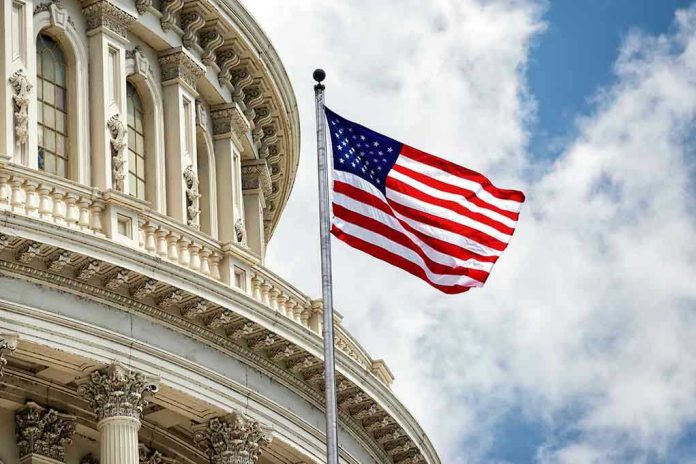
As China’s military ambitions escalate, the U.S. Army has declared Beijing the “pacing threat” while throwing its full support behind President Trump’s aggressive new focus on defending America’s homeland and securing the border.
Story Snapshot
- Army Secretary labels China the top threat and endorses Trump’s border security push.
- Military leaders warn of Chinese preparations for a Taiwan invasion and regional dominance.
- Trump’s administration prioritizes military deployments both overseas and at the southern border.
- Experts debate balancing Indo-Pacific deterrence with expanded homeland defense and domestic operations.
Army Leadership Identifies China as America’s “Pacing Threat”
At the annual Association of the U.S. Army conference in Washington, D.C., Army Secretary Dan Driscoll underscored a new era in American defense strategy. Driscoll declared that China is the “pacing threat” to U.S. national security, meaning that Beijing’s military advances are setting the benchmark for American defense planning. This public acknowledgment marks a clear and urgent warning: China’s rapid military modernization, regional aggression, and technological rivalry now drive U.S. defense priorities both abroad and at home.
Driscoll’s remarks come as President Trump and his top defense officials double down on the necessity of defending the homeland as vigorously as projecting power overseas. The Army Secretary emphasized that, while deterring Chinese aggression in the Indo-Pacific remains critical, the Trump administration’s intensified focus on border security and domestic military deployments is now integral to national defense. This dual-priority approach directly links international military threats with the need for robust security at America’s borders and within its communities.
Trump Administration’s Dual-Priority Defense Strategy
Since returning to office, President Trump has moved swiftly to reorient U.S. military priorities. The administration’s strategy, as articulated by both Secretary of Defense Pete Hegseth and Joint Chiefs Chairman Gen. Dan Caine, centers on deterring Chinese ambitions—especially regarding Taiwan—and reinforcing U.S. dominance in the Indo-Pacific. At the same time, Trump’s team has ordered sustained military deployments to the southern border, supporting Immigration and Customs Enforcement and the Department of Homeland Security in stemming illegal immigration and defending against transnational threats. This marks a clear shift from prior administrations, with a renewed emphasis on the constitutional mandate to protect the American people from both foreign and domestic dangers.
Military leaders and policymakers are implementing posture adjustments in the Indo-Pacific, conducting joint exercises with allies like Japan and Australia, and expanding intelligence and surveillance to counter China’s growing capabilities. Simultaneously, the Army and National Guard support border operations—demonstrating the Trump administration’s resolve to address the threats of illegal immigration and cartel activity head-on, rather than ceding ground to globalist or “woke” priorities that many conservatives believe have weakened U.S. sovereignty and security in recent years.
Expert Opinions and Risks of Dividing Focus
Defense analysts warn that China’s military modernization—including expanded naval, missile, and cyber capabilities—poses a genuine risk of outpacing the U.S. if not countered with sustained investment and innovation. Congressional hearings and posture statements throughout 2025 have repeatedly highlighted Beijing’s preparations for a possible Taiwan invasion and its broader strategy to challenge U.S. influence in Asia. However, some experts caution that overemphasizing homeland defense and border deployments could dilute resources and focus from critical overseas deterrence missions, particularly in the Indo-Pacific theater where U.S. allies depend on American leadership to maintain regional stability and counter Chinese aggression.
Scholars and policy professionals continue to debate the appropriateness of using military forces for domestic operations. While the Trump administration and its supporters argue that such measures are vital to defend the Constitution, national sovereignty, and the American way of life, critics worry about the sustainability of this dual-priority approach and the risk of eroding the traditional separation between military and civil authority. Nevertheless, the consensus among senior defense officials is clear: the United States must be prepared to defend its interests on multiple fronts, refusing to allow foreign adversaries or open-border advocates to undermine American security or values.
Long-Term Implications for National Security and American Values
The Army’s new posture under Trump signals a lasting shift in how America handles threats both from abroad and within. In the short term, the nation faces heightened military tension with China, increased exercises with allies, and a more visible military presence at home. Over the long term, this strategy could lead to an arms race in the Indo-Pacific and a permanent militarization of border security. Defense spending is being prioritized for modernization, readiness, and domestic operations, while political debates rage over the appropriate balance between overseas commitments and homeland defense. What remains clear is that, for Trump’s supporters and many conservatives, the days of neglecting the border and turning a blind eye to global adversaries are over—America’s military is once again being used to protect the people, uphold the Constitution, and defend national sovereignty first.
As the Trump administration solidifies these priorities, the message from Army leadership and the White House resonates with millions of Americans who have grown tired of failed policies, open borders, and globalist agendas. The coming years will test the nation’s ability to balance its commitments abroad with the enduring need to secure its own homeland—reflecting the core conservative belief that a strong America at home is the foundation for peace and leadership abroad.
Sources:
Focus Taiwan (CNA): Congressional testimony and DoD statements on China threat.
U.S. Army official news: Army deterrence strategy and regional exercises.
Defense One: Army Secretary’s remarks and policy analysis.
USINDOPACOM Posture Statement (April 2025): Strategic assessment of China.
Congressional record: Secretary Hegseth’s testimony.
DoD transcript: Secretary Hegseth’s keynote address.














